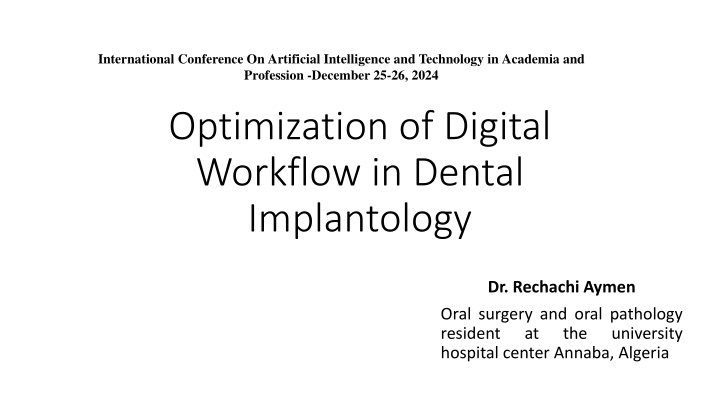
Digital Workflow Optimization in Dental Implantology - Revolutionizing Implant Dentistry
Explore the transformative impact of digital tools in implant dentistry, from advanced diagnostics to guided surgical placement and prosthetic restoration. Learn how technologies enhance precision, efficiency, and patient outcomes at every stage of the implant process.
Download Presentation

Please find below an Image/Link to download the presentation.
The content on the website is provided AS IS for your information and personal use only. It may not be sold, licensed, or shared on other websites without obtaining consent from the author. If you encounter any issues during the download, it is possible that the publisher has removed the file from their server.
You are allowed to download the files provided on this website for personal or commercial use, subject to the condition that they are used lawfully. All files are the property of their respective owners.
The content on the website is provided AS IS for your information and personal use only. It may not be sold, licensed, or shared on other websites without obtaining consent from the author.
E N D
Presentation Transcript
International ConferenceOnArtificial Intelligence and Technology inAcademia and Profession -December 25-26, 2024 Optimization of Digital Workflow in Dental Implantology Dr. Rechachi Aymen Oral surgery and oral pathology resident at hospital center Annaba, Algeria the university
Plan : Introduction Pre-Operative Diagnostics Implant Planning Guided surgical placement Prosthetic phase Benefits of digital workflow Conclusion
Introduction: Implant dentistry is experiencing a transformative revolution with the integration of digital technologies. Tools like intraoral scanners and CAD/CAM systems have simplified diagnostics, improved treatment precision, and streamlined workflows. These advancements enhance the overall efficiency of implant procedures, benefiting both clinicians and patients. The objective of this presentation is to highlight the significant impact of digital tools at every stage of the implant process, from diagnosis and planning to surgical execution and prosthetic restoration.
1/Pre-Operative Diagnostics: The Intraoral Scanners: Provide fast and accurate digital impressions. Eliminate the need for traditional molds, improving patient comfort. Cone Beam Computed Tomography (CBCT): Captures detailed 3D images of the maxillofacial anatomy. Enables detailed assessment of bone structures, densities, and anatomical constraints. Benefits: Faster diagnosis, improved precision in planning, and preservation of critical structures.
2/Implant Planning: Planning Software: Combines CBCT data with intraoral scans to create highly accurate virtual models. Simulates implant positioning, considering: Bone density. Nerve locations and other sensitive areas. Prosthetic alignment. Surgical Guides: Custom-made guides ensure precise implant placement. Outcome: Better surgical preparation reduces risks and enhances outcomes.
3/Guided Surgical Placement: Techniques: Use of customized surgical guides for predictable and accurate procedures. Enables minimally invasive incisions and reduces room for error. Advantages: Reduced surgical complications. Shorter operation times. Faster patient recovery. Real-Time Technology: Navigation systems using CBCT data to guide the procedure in real-time.
4/Prosthetic Phase: CAD/CAM Technology: Used to design and fabricate temporary and final restorations. Precise adaptation achieved through milling or 3D printing. Custom Restorations: Perfectly tailored to the patient s needs. Improved aesthetics and long-term durability. Patient Visualization: Allows patients to visualize the final results digitally, improving treatment acceptance.
5/Benefits of Digital Workflow: Improved Accuracy: Every step is carried out with high precision. Time-Saving: Reduced delays between diagnosis and treatment completion Enhanced Communication: Digital models and simulations help patients understand the process better . Long-Term Impact: Fewer adjustments required due to precise restorations
Conclusion: Digital workflows optimize every phase of implantology, improving precision and patient satisfaction.While challenges remain, the long- term benefits outweigh the initial obstacles.Future technologies will continue to reshape this field, offering even more opportunities for success
